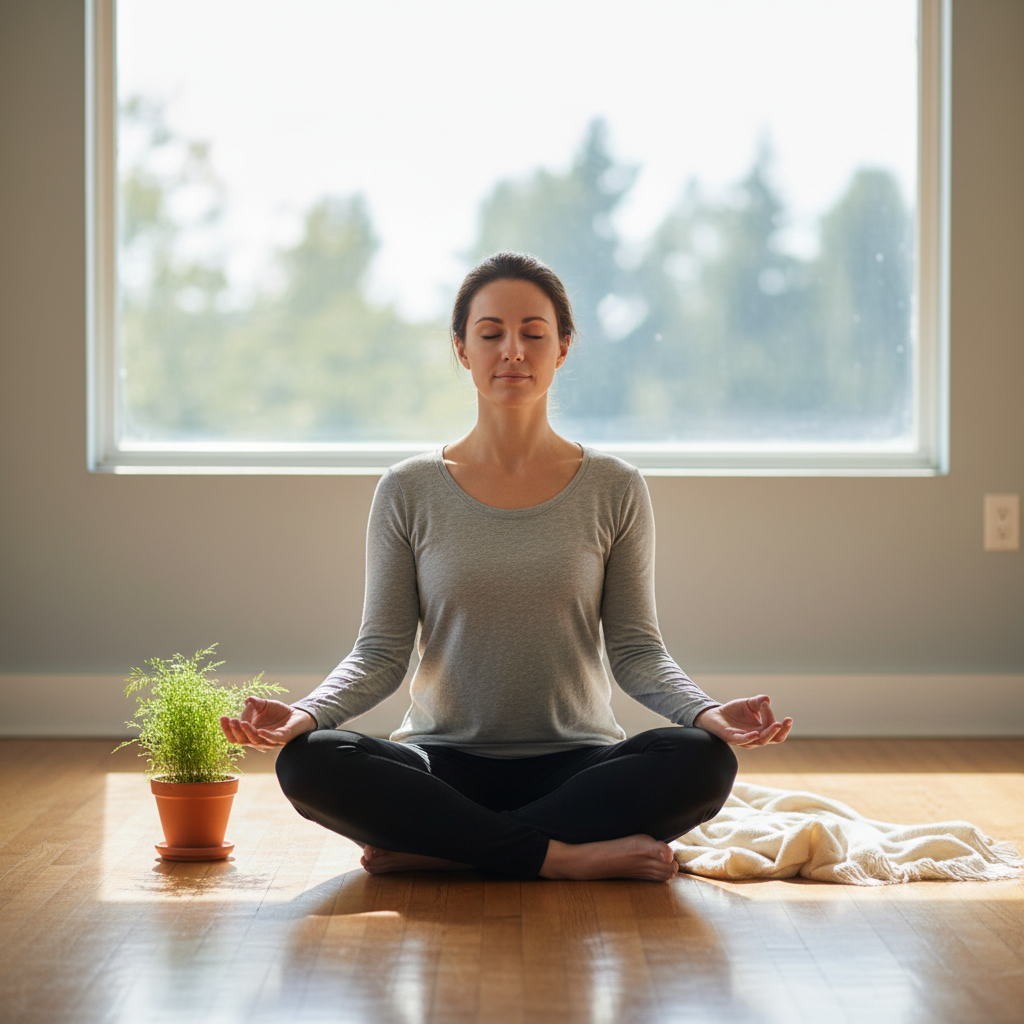Daily Mindfulness Practice for Beginners: Easy Ways to Live Presently
My Mindfulness Journey: From Chaos to Calm

Ever feel like your brain is hosting a nonstop 24/7 game show called “What Did I Forget This Time?” Spoiler alert: it’s exhausting. Welcome to the empowering world of daily mindfulness practice for beginners — simply paying attention without losing your mind. And before you imagine meditation as a snooze fest, hold up! This guide will show you simple, engaging ways to embrace mindful living.
A few years ago, my mind was like a squirrel on espresso — constantly racing, stressing about everything. Then I discovered that daily mindfulness doesn’t require long hours or complicated rituals. Taking just 2-5 minutes each day to breathe and be present transformed my chaotic thoughts into calm clarity. If I can do it, so can you.
Key takeaway: Even a few minutes of mindfulness can significantly reduce stress and improve mental well-being.
What Is Mindfulness and Why Is It Important?

Mindfulness means pausing the mental clutter and tuning fully into the present moment without judgment. Imagine savoring your morning coffee at a new level of awareness or simply noticing the little details around you.
Research shows that daily mindfulness practice can benefit your mind and body in many ways:
- Melt away stress, anxiety, and occasional existential dread
- Improve sleep quality and enhance focus — say goodbye to distracting mental noise
- Help regulate emotions effectively
- Support healthy habits by boosting awareness
- Elevate happiness and emotional resilience
For more science-backed insights, visit Harvard Health’s overview of mindfulness benefits.
Key takeaway: Mindfulness acts as your brain’s reset button — no software update required.
How to Start Your Daily Mindfulness Practice for Beginners

1. Start Small & Be Consistent
You don’t need to become a zen master overnight. Just 2-5 minutes a day is enough to start. The secret is consistency — doing it every day. Think of it as flossing for your brain.
2. Find Your Time & Space
Choose a time that fits your routine — morning, lunch break, or after brushing your teeth. Find a quiet spot where you won’t be disturbed by distractions or interruptions, whether from your cat, your phone, or your inner monologue.
3. Focus on Your Breath
Close your eyes or soften your gaze. Notice the air flowing in and out of your lungs. When your mind wanders — maybe thinking about “What’s for dinner?” — gently guide your focus back to your breathing. No judgment needed.
4. Try Simple Mindfulness Exercises
- Mindful Breathing: Like a candle blowing contest, but without candles or competition.
- Body Scan: Slowly observe sensations from your toes to your head without judgment.
- Mindful Walking: Notice your steps, your shoes, the ground, and even that enthusiastic neighbor waving.
- Mindful Eating: Savor each bite like it’s a flavor celebration.
5. Use Reminders
Set alarms, sticky notes, or enlist a mindfulness buddy (mine happens to be my 7-year-old’s eye rolls) to remind you to pause and be present.
Key takeaway: Begin with small steps, remain consistent, and integrate mindfulness into your daily routine—even at stressful moments like rush hour.
Beginner Mindfulness Practice Tips From An Authoritative Yet Friendly Uncle

- Mind wandering? That’s normal. Your role is to recognize distractions and gently return to the present.
- Make everyday moments mindful. Activities like brushing teeth, washing dishes, or petting your dog are perfect mindfulness opportunities.
- Celebrate small victories. Every calm moment is progress toward greater self-mastery.
Key takeaway: Mindfulness is a journey, not a race — bring patience and maybe some snacks along the way.
What You’ll Need to Begin Mindfulness
- A cozy spot that’s mostly quiet (extra points if no one’s yelling, “Where’s my shoes?!”)
- A timer, mindfulness app, or your phone’s gentle alarm
- An open mind and patience — some days your brain might feel like a wild toddler
Step-by-Step Morning Mindful Breathing (Because Why Not Start Your Day Zen?)
- Sit upright but relaxed, as if ready for a thoughtful TED Talk, not a nap.
- Close your eyes or soften your gaze; try for serene — even if your cat judges you.
- Breathe naturally; optionally count breaths to play a calm version of brain bingo.
- When distracting thoughts pop up (“Did I pay the electric bill?”), acknowledge them and let them go.
- Repeat this for 2–5 minutes; over time, you might extend your practice naturally.
Key takeaway: Just five mindful minutes in the morning can positively shift your entire day.
Personal & Local Relevance of Mindfulness
In my community, mindfulness is more than a buzzword. From group sessions to mindfully exploring local parks, people are embracing calm amidst the chaos. This collective practice acts as a communal deep breath, fostering peace and connection in daily life.
Key takeaway: Mindfulness builds inner peace and strengthens neighborhood vibes alike.
FAQ: Because You’re Probably Wondering
Q1: Can I do mindfulness anywhere?
Absolutely! Whether standing in line or stuck in traffic, mindfulness can happen anywhere you are.
Q2: What if my mind won’t stop wandering?
That’s perfectly normal. Gently notice wandering thoughts and lovingly guide your attention back to the present.
Q3: How long should I practice daily as a beginner?
Start with 2-5 minutes daily. Remember: baby steps are still progress.
Q4: Are there apps that help?
Yes! Apps like Calm, Headspace, and Insight Timer offer excellent guided mindfulness practices.
Key takeaway: Asking questions shows you care. Keep practicing, and keep learning.
Now that you’re equipped with essential tips on daily mindfulness practice for beginners, it’s time to embrace the present moment. If your mind still feels chaotic, remind it that even the wildest brain deserves a coffee break… from itself.
Still reading? You’re officially my favorite. Now go breathe.


